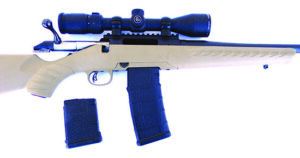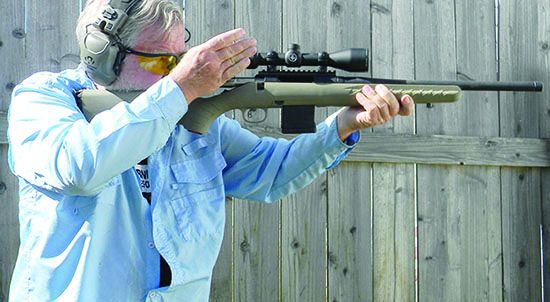Mid-caliber carbines are very popular. Many are chambered in popular offerings, such as 30-06 Springfield, 7.62x39mm (or 7.62 Soviet), 300 Blackout, 308 Winchester, and 30-30 Winchester, to name but a few. These traditional cartridges have proven useful in semi-auto, lever-action, and single-shot handy rifles, and some have been adapted to bolt-action carbines, which like the other action types, can be reliable, fast handling, accurate, versatile, and safe. As a ranch rifle, for instance, a bolt-action carbine can ride with an empty chamber and the bolt partially closed on top of rounds in a magazine and out of battery, then the shooter can work the bolt quickly to chamber a round and fire to drive pests or predators from the property or take medium game at moderate ranges. Also, short, light carbines may not be ideal for personal defense because of their low rate of fire, but they could serve in that role if need be.
We wanted to take a look at 30-caliber bolt guns and find one that compares well in power and overall length to a 30-30 lever gun, with detachable-box magazines that supply similar or greater round counts than lever magazines. We chose two carbines, a new 7.62x39mm model from CZ and a Ruger in 300 Blackout. The CZ 600 Alpha Rifle No. 07403 isn’t offered in 300 Blackout, but it is offered in 7.62×39, which we hoped would offer affordable ammo.
We looked hard at differences in pricing between 300 Blackout and 7.62×39. In quality hunting ammunition with jacketed soft-point bullets, we were surprised that the differences were not that much. In fact, sometimes the 7.62×39 was more expensive. We reasoned that not a lot of hunters use the AK rifle cartridge to hunt, so it cannot be a big seller as a deer round. In full-metal-jacket loads, however, the 7.62x39mm was much less expensive. We found some 7.62×39 ammunition for $4.40 for 20 rounds, or 22 cents a round. Nothing in 300 Blackout could touch that price. The best price we found for 300 Blackout FMJs was $12 for 20 rounds, or 60 cents a round. Fiocchi 300 Blackout FMJs, 50 rounds, were $43 (86 cents per round). In other bullet types, we found Hornady Black 7.62×39 123-grain SSTs at $30 for 20 rounds ($1.50 per round), while Hornady Custom CX 110-grainers in 300 Blackout were $32 ($1.60 per round). In muzzle energy and velocity, the 7.62×39 beats the 300 Blackout across the board, as the Range Data table shows. The only real advantage 300 Blackout holds is the ready availability of subsonic ammunition for suppressor use.
These rifles were each noted for low recoil. While one stock handled recoil better, each of these rifles is easily rated as a light kicker compared to a 30-30 WCF or 308 Winchester. Yet with proper loads, either is qualified as an American deer rifle. The 30-30 is often hailed as a baseline for power in taking deer-sized game, but in our experience, the 30-30’s performance deficit in lever guns is more about accuracy than power. Old-style buckhorn sights common on lever guns are hard to shoot accurately, so shot placement suffers. Modern bolt-action carbines are easily scoped and, in most cases, offer good accuracy. We fitted the CZ with a SIG Buckmaster 3-9×40 optic, an affordable riflescope that has given good results on other rifles. We used a Vortex 3-9×40 Crossfire II on the Ruger.
One of our test guns, however, wasn’t that accurate, as you can read below.
Ruger American Ranch Rifle 26968 300 BLK
$502
Gun Tests grade: B-
The Ruger American is a reliable and affordable rifle. It handles well and is accurate enough for most chores. The price differential between the Ruger and the CZ rifle isn’t that great, and the CZ simply outperformed the Ruger. After some work that is rightly classified as elbow-grease gunsmithing, we were able to get the Ruger smoother.

| Action Type | Bolt |
| Overall Length | 36.0 in. |
| Barrel | 16.125 long, 1-in-7-in. twist |
| Overall Height w/Scope | 6.25 in. |
| Weight Unloaded | 6.0 lbs. |
| Weight Loaded | 6.5 lbs. |
| Action Finish | Black |
| Barrel Finish | Black |
| Magazine Capacity | 10 as issued; 5, 20, 30 available |
| Stock | Synthetic |
| Drop at Comb | 0.5 in. |
| Drop at Heel | 0.75 in. |
| Bedding | Metal pillars |
| Buttpad | Soft rubber |
| Length of pull | 13.75 in. |
| Scope Base Type | Ruger |
| Trigger Pull Weight | Adjustable |
| Warranty | None Listed |
| Telephone | (334) 949-5200 |
| Website | Ruger.com |
| Made In | U.S. |
We purchased the test rifle for $502, although we found similar rifles online for as much as $599. Introduced in 2011, the Ranch Rifle features a detachable AR-type magazine, an advantage in adding capacity easily. We used both five-round magazines and the issued 10-round magazine and additional higher-capacity magazines. The five-round magazine was blocked with MagPul five-round limiters, useful when game laws limit magazine capacity and in firing off a bench. Magazines are easily available and affordable, not so the CZ. Magazines of five to 30 rounds are available at most any shop. We did not use high-round-count magazines during the benchrest firing because it is unwieldy, but we did use larger mags in some of the offhand firing tests.
The rifle features a 16-inch barrel and synthetic stock. The rifle seems robust and offers a short bolt throw. The bolt action is not smooth, however, and while it never failed to feed, the eject cycle is not as smooth as the feed cycle. Feed reliability was there, but despite constant manipulation, the new rifle’s bolt never smoothed up. Lubrication did not help. The rifle features what Ruger calls power bedding, allowing a free-floating barrel. The rifle is overall competently designed and executed. The barrel does not lay against the stock, and with this free-floating barrel, accuracy potential should have been enhanced.

The barrel is a threaded unit measuring just over 16 inches. The barrel is collared into the receiver in a manner pioneered by Savage that is both economical in production and solid in hard use. The rifle is nicely finished, with the fit even between the receiver and barrel. The stock is synthetic. It is lightly roughened in the pistol grip and fore end. We rated it several steps below the CZ rifle in adhesion and abrasion. We never lost our grip on the rifle; it simply did not feel as secure as the CZ 600 Alpha. The stock design is interesting with its generous magazine well. While a bolt-action rifle is a sporting gun, if you want magazine capacity and rapid speed loads, the Ruger wins by a margin over the CZ. Other features are an easily used Picatinny scope mount, sling swivel studs, and a thin recoil pad.
We fired the rifle in two test steps. First, while we chronographed a number of loads while sighting in on paper, we narrowed the selections down to three loads for bench accuracy. Results were not terribly impressive because the rifle averaged a 2.0-inch spread, with some groups larger. A quality modern bolt gun with a decent scope usually does better, even the box-store package guns. Our rifle wore a decent scope that has given good results on several rifles, so we put the lack of accuracy on the gun.
We didn’t initially adjust the Ruger’s Marksman Adjustable trigger for the test. Both it and the CZ were delivered at 2.5 pounds, and we left them there for most of the testing, eventually dialing each down to 2.0 pounds in search of greater accuracy. The Ruger stock must be removed to adjust the trigger, the CZ does not require that. Next, we walked to the 50-yard line and fired 60 rounds in several runs at torso-sized targets. The CZ was also fired in the same regimen, bench accuracy to speed runs.

The Ruger bolt features a 70-degree throw and three locking lugs. It is strong, no question there. But it wasn’t very smooth, and we struggled to make a good time on the speed course. We struggled at times to get the rifle bolt back into line. There may be too much slop in the action for fast operation. Still, the bolt is well designed, with a robust extractor and ejector. Disassembly is simple, press a lever on the receiver, and the bolt slides out. The safety is located behind the bolt. We found this safety superior to the CZ’s vertical safety bolt. The Ruger is fast and positive in operation, and the magazine release is also positive in operation.
As we compared the rifles, one rater posited that perhaps the Ruger cycled rougher than we liked because of how the short 300 Blackout cartridge fed. No, another rater noted, he has fired a 7.62×39 version of the Ranch Rifle that was also rough, although he found it to be a useful truck gun. The Ruger never tied up, but we will stress that it made us work for our cycles. The rifle was not very accurate off the bench, but it was consistent. We checked the scope mounts and stock screws, all were good and tight.
Accuracy was very interesting because the Black Hills ammunition and Hornady Custom loads were consistently similar in accuracy. Some of the more affordable loads were terrible in personal tests conducted by a rater who stated he was going to keep one or the other rifle for his own use and did a good bit of solo work. Some ammunition went over 3 inches for three-shot groups. This accuracy deficit was not offset by an ability to quickly pour lead into a target at 50 yards.
Our Team Said: The Ruger rifle was simply not smooth. In the end, the Ruger American Ranch Rifle was reliable, and what accuracy it exhibited was consistent, but not impressive.
| RANGE DATA | |
| Black Hills Factory New 110-grain Tipped TSX UL076230 | Ruger American Ranch Rifle 300 BLK |
| Average Velocity | 2257 fps |
| Muzzle Energy | 1244 ft.-lbs. |
| Small Group | 1.6 in. |
| Average Group | 1.9 in. |
| Hornady Custom 110-grain CX 808794 | Ruger American Ranch Rifle 300 BLK |
| Average Velocity | 2309 fps |
| Muzzle Energy | 1302 ft.-lbs. |
| Small Group | 1.8 in. |
| Average Group | 2.3 in. |
| Federal Fusion MSR 150-grain BSP F300BMSR2 | Ruger American Ranch Rifle 300 BLK |
| Average Velocity | 1910 fps |
| Muzzle Energy | 1215 ft.-lbs. |
| Small Group | 1.6 in. |
| Average Group | 2.1 in. |
How we tested: We fired groups at 100 yards from a benchrest position using an MTM Case-Gard K-Zone Shooting Rest. We used a Competition Electronics Pro Chrony to measure muzzle velocities. Notes: TSX = Triple-Shock X copper bullet.
CX = Copper alloy eXpanding bullet. BSP = bonded soft point. SST = Super Shock Tip bull
Written and photographed by Gun Tests Staff, using evaluations from Gun Tests Team members. GT




























